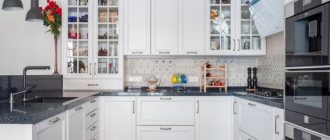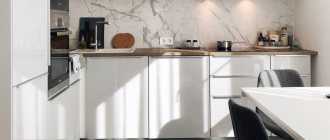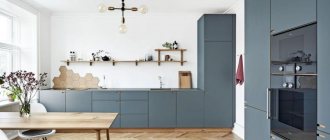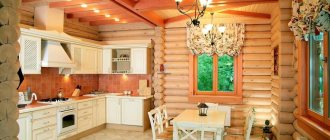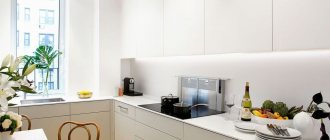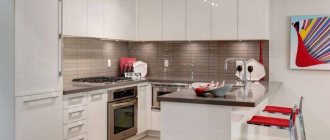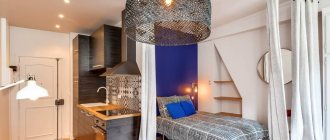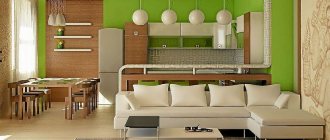How to determine the size of an apron
This is the first place where the drafting begins. Most often, the height of the apron is 60 centimeters: this size is considered balanced and is perfect for people of short and medium height. But such people, especially among women, are the majority.
Designer tips
Irina
Irina Polyakova is the founder of an interior studio, architect and interior designer. The main area of work is kitchen design
I recommend to my clients to lower the apron a little (for example, 50-55 cm) if the upper cabinets on the door closers open upwards rather than to the side. This helps to avoid those awkward situations when not the tallest housewives have to call taller household members for help or stand on a stool to cover them
You should not carefully measure the indicated 0.6 meters down to the last millimeter: anyway, the edges of the material are hidden under the upper cabinets and countertops.
If you use a hood, then remember the “75-80 cm rule” - the optimal distance between it and the hob. The wall behind the hood can be decorated in the same manner as the apron. However, this is purely a matter of your taste.
If you decide to make the kitchen more spacious and abandon the top altogether, then it is best to extend the apron all the way to the ceiling. This design brings a nice Mediterranean or Scandinavian touch to the interior, where free space and ease of design are valued.
The voids can be filled with ordinary shelves. This is not only aesthetically pleasing, but also practical.
However, the option where the apron occupies about a third of the adjacent wall is also quite workable. The main thing is to competently play with the transition between materials.
The width of the apron depends on the type of kitchen unit and almost always corresponds to its length: if the layout is L-shaped, then we continue finishing around the corner - and so on around the entire perimeter.
Read more about corner kitchens here.
Designer tips
Irina
Irina Polyakova is the founder of an interior studio, architect and interior designer. The main area of work is kitchen design
Do you want to be original? Design a combined surface, where the sink and hob areas are decorated with one material, and everything else with another. This idea is often used in advanced interiors in terms of design ideas.
Factory marking
Like any artificial material in Russia and Europe, linoleum is manufactured according to international GOST.
The class of linoleum for the kitchen can be easily determined by the marking, consisting of four numbers:
- 21-23. Intended for residential use only;
- 34-31. Can be used in offices;
- 41-43. Flooring for industrial enterprises.
The letter code located immediately after the number indicates the degree of abrasion of the product: F - strong, MP - medium, T - weak.
What could the design and color be?
It is logical that the design of the apron directly depends on the design of the kitchen as a whole. A bright accent on this area with a neutral interior will look at least inappropriate. Therefore, when choosing:
- focus on the color of your facades, floors, curtains or countertops;
- avoid an overly grainy texture - it is extremely difficult to care for;
- Be careful with shades of black - water droplets and grease are especially noticeable on such a surface.
Our articles will help you decide on a color choice: 105 of the most stylish kitchen interiors in gray tones 143 fashionable beige kitchen interiors 120 photos of the most beautiful white kitchen interiors 109 fashionable kitchen interiors in blue tones
Very often, the apron is made in the same vein as the tabletop: the same material and texture, identical motifs. Differences may be in color intensity: a tone lighter or, conversely, darker. The white version, as in the photo below, is among the most common.
The opposite case is when a darker apron becomes a noticeable accent in a neutrally decorated room. Largely due to the integration of stone texture. Along with wood, it is appropriate for almost any kitchen.
Another way to beautifully highlight a backsplash is with an artistic panel. It is made from
- plastic;
- glass;
- ceramic tiles.
You have complete carte blanche to choose the type of image. True, appeals to kitchen themes (food, fruit, glasses, coffee, cups, plates) are among the most frequent.
For loft and high-tech it would be appropriate to preserve the “native” concrete texture. But you still have to prepare it: for example, varnish it, so that later you don’t have to spend hours (and unsuccessfully!) washing the walls from dirt and grease stains.
Owners of small kitchens can use a little trick and use an apron with horizontal lines. You will get an interesting optical effect of expanding space. Both striped plastic panels and popular ceramic subway tiles are suitable. It is also often called a “hog” due to Soviet custom.
You will find more options for designing a kitchen backsplash with boar tiles here.
Abstraction
Ornament in the form of geometric shapes allows you to balance spatial solutions and hides many design errors.
Having determined the desired color spectrum, you should not rush to purchase - you need to familiarize yourself with the other characteristics of the coating.
Release size and form
Traditionally, linoleum is produced in rolls 1.5-5 meters wide and 6 meters long (technical - up to 45 m). Considering that the average size of a kitchen in a typical typical apartment is 5-6 square meters. m., the material has to be cut and adjusted.
Before purchasing, you need to decide on the required quantity of goods, for which the floor area is calculated and 5-8 cm is added to the resulting value for possible shrinkage.
To avoid painstaking adjustments, two revolutionary new forms of flooring were created:
Linoleum for the kitchen under tiles, that is, in the form of square or rectangular panels. They are easy to adjust to all corners of the room, and replace if necessary (for example, if an area is stained or burned), but during installation a lot of seams are formed, which is undesirable for the kitchen;
Liquid linoleum. The popularity of self-leveling floors is steadily growing due to significant advantages: no seams, complete waterproofing, hygiene. The coating can become the basis for traditional linoleum flooring.
Best materials
If there is a question that inevitably causes headaches when posed, it is this: what material is best to make an apron from? There are many of them - and each has its own obvious advantages and no less obvious disadvantages.
Tile
The first thing that comes to mind - and this is quite fair. Still, ceramic tiles are not afraid of water, fire, or alkali, are easy to clean and are almost eternal.
Probably, even in ten years, the boar tile will not lose its relevance. Available in sizes 10x30, 10x20, 8.5x10, etc. Such collections can be found in the catalog of any manufacturer. The differences are only in color variations.
When laying ceramics on a backsplash, seams inevitably remain. They should be rubbed down with a waterproof fugue: it retains the color better and does not fall out. When choosing a grout color, you have two options:
- make seams to match the tiles;
- follow the contrast method.
There are rectified tiles on sale - they are cut along the edge at an angle of 90 degrees and are joined with a minimum seam of 1 mm. This creates a cool solid surface effect.
Patchwork is another way to beautifully highlight this area, making it the main detail of the interior. The pattern on such a tile is not solid, but is a canvas woven from shreds with different patterns. Such elements are ideal for Mediterranean design, as well as for kitchens decorated in Provence or country style. You can choose collections where the tiles have a larger format: they are much easier to lay, and there will be fewer seams.
But for high-tech, embossed surfaces that are stingy with emotions are always relevant. However, when used correctly and with skillfully adjusted lighting, they demonstrate considerable decorative potential. But remember: with matte surfaces you will have to spend a little more time cleaning.
Designer tips
Irina
Irina Polyakova is the founder of an interior studio, architect and interior designer. The main area of work is kitchen design
The latest fashion is to lay ceramic floor tiles, stylized as wood, on the backsplash. There are pitfalls here: if the surface has an overly active topography, it will be very difficult to wash it off from dirt.
Expert opinion
Dmitriy
Sales consultant in a ceramic tile store
The problem of seams is easily solved by choosing large-format porcelain tiles with a polished or matte surface. We are talking about the size 60x120, which is literally created for modern aprons: minimal trimming, a beautiful and clear monolith, excellent compatibility with any type of tabletop. Such porcelain tiles are universal and are also used as flooring, but there are also exclusively facing collections with a thickness of 6-7 mm, where the weight of each tile does not exceed 5-6 kg.
Glass skins
Let’s clarify right away: high-strength tempered glass is used to decorate the apron. The technology is simple: a transparent screen is cut out based on the measurements taken and covers any initial wall finish. For example, photo wallpaper or vinyl stickers, as in the images below.
Such glass does not crumble into fragments, but into small and not at all sharp pieces, so the risk of injury is reduced to zero. Pros:
- durability;
- immunity to water and fire;
- easy care;
- solid decorative potential.
There are also options for skinning with photo printing. The higher its quality, the longer the design will retain its freshness and color. True, the price for such work is steep - and this is the main drawback of tempered glass as a material.
MDF panels and postforming
A great way to inexpensively and aesthetically decorate an apron. Especially suitable for those who are partial to the texture of wood - and want to fit it into the format of their kitchen. Fortunately, there are options on the market for a variety of breeds - you can satisfy any “wants”, and the convenient format fits well into the allotted height of 60 cm - there is less trimming and fuss with fitting.
Those who use a gas stove should look for other design methods: the material is afraid of high temperatures. Of course, you can always protect it with a tempered glass screen, but this is an additional expense - and it is not always possible to design the insert organically.
A good alternative is postforming , which is based on chipboard covered with laminated paper. Such an apron will definitely withstand any temperature influences, will not fade in the sun and will not lose its appearance. Since the strength is high, the material is also used as a tabletop. The result is an interesting monolith that brings orderliness and harmony to the interior.
Be careful: the cheaper the stoves, the more likely they are to contain resinous substances that are unacceptable in the area where food is prepared. Therefore, be sure to check the composition of the material with sellers: your health and safety come first.
Metal
If your kitchen is decorated in a strictly modern style, it makes sense to pay attention to stainless steel as a material for decorating the apron:
- reference wear resistance;
- does not scratch;
- is not afraid of fat, water, or fire;
- gives a beautiful mirror effect;
- goes well with the chrome inserts of the kitchen set.
It seems to have been created specifically for linear high-tech interiors, radiating cold calm and calm, restrained beauty. It is inexpensive and can be easily mounted on the wall, even by those who are only comfortable with a hammer and drill.
Metal does have one drawback - maintenance. Here housewives need to come to terms with the fact that traces of fat, fingers and other cooking artifacts will always be visible on the steel surface.
Mirror
On one side of the scale there is a magnificent reflection effect, due to which even the smallest kitchen is completely transformed and acquires a nice volume.
On the other hand, there are the difficulties of cleaning, because grease and water are clearly visible on the mirror surface. Are you ready for this?
This is how you can describe the advantages and disadvantages of a mirror apron.
Designer tips
Irina
Irina Polyakova is the founder of an interior studio, architect and interior designer. The main area of work is kitchen design
Of course, an infinitely nice option that makes a dark and uncomfortable room spacious and bright. It’s also cute because it easily fits into classic and modern. Just be careful with the shelves and kitchen utensils on it: such an apron reflects not only your beautiful face, but also numerous knives, forks, spatulas and other items from the housewife’s arsenal.
If you wish, you can choose a golden-colored mirror tile and play with the color of the fittings in your kitchen in this simple way.
Mosaic
One of the most impressive ways to decorate an apron. It looks bright, fresh, rich and stylish. May be:
- glass;
- ceramic;
- from natural stone;
- smalts.
Or from different components on one sheet, due to which it shimmers beautifully when illuminated and is equally successfully implemented into any design concept.
For example, a mosaic decorated in a metallic color fits perfectly into laconic and linear modern interiors. It is in them that it becomes the main accent, which attracts attention and makes the environment unique.
Individual pixels of a mosaic canvas can give an interesting mirror effect. In combination with beautiful lighting, it often looks simply stunning even in a relatively modest interior.
Smalt mosaic consists of a large number of glass cubes and plates connected to each other on a grid of any size. One sheet can have several shapes and a dozen colors at once, so such bright and rich elements will certainly appeal to fans of the colorful Mediterranean style.
By connecting sheets together on the apron space, you can achieve a smooth transition from one color to another. This gives rise to amazing harmony and charges the space with healthy energy.
Small pixel sheets contain countless numbers of equal sized cubes. Due to the mesh base, you can cut fragments to the desired height and length without any loss to the aesthetic concept. True, the boundaries between the pixels require methodical erasing: an epoxy fugue is suitable.
A reasonable question arises: if mosaic looks so amazing in the kitchen, why is it still not so often seen in modern interiors? The answer is simple: it is an expensive pleasure. In addition to the high price of the material itself, the costs will also need to include an increased fee for the installer for installation.
A large number of stitches makes care difficult and often even exhausting. However, there is always a way out.
Expert opinion
Dmitriy
Sales consultant at a ceramic tile showroom
If the mere thought of grouting mosaic joints makes you reach for the medicine cabinet for valerian, pay attention to ceramic granite imitation. Visually, it is still the same mosaic, but made using embossing technology. It is laid like a regular tile and grouted to match the color of the joints modeled on the surface. This is a good compromise for those who are delighted with mosaic compositions, but cannot afford such an expensive and capricious pleasure in everyday life.
Plastic panels
The cheapest and easiest way to solve the issue of an apron, which is suitable for those who live, for example, in a rented apartment. Or he simply does budget repairs.
PVC panels are attached to the wall using an aluminum profile and a small amount of glue. At the same time, it does not need to be prepared: it will be fixed even with visible defects and curvature. They are thin and light, so installation is simple and there is no need to call specialists for help.
One of the advantages of plastic for an apron, along with basic installation, is the wide selection of textures and colors. There really is EVERYTHING on sale - and sometimes it’s even difficult to determine that it’s PVC and not a more expensive and solid material.
Cons: plastic is not very durable, scratches easily, quickly fades in the sun. Usually its service life does not exceed 3-4 years. In addition, you cannot put it in the kitchen with a gas stove: it melts at high temperatures.
Artificial and natural stone
Man's desire for harmony with nature motivates him to surround himself with natural textures. Therefore, aprons made of artificial and natural stone are always relevant - and will remain so, even despite the huge amount of innovative materials generated by modern technologies.
The combination of an apron and a countertop made of the same stone is a completely logical design solution. At the same time, it is important not to overdo it with the amount of dark in the space: if you see that too much is brewing, restore the balance with light facades and friendly flooring.
Granite is always popular. Natural is quite expensive, but artificial - in the form of tiles 1.5-2 cm thick - will cost much less. Very dense and durable, not afraid of water, fire, or dirt. In general, a material that has practically no weak points.
Marble is more suitable for classic interiors that are meticulous to the smallest detail, where solidity, noble appearance and even some pomp are held in high esteem. Only in the good sense of the word.
Slate and brick also fit perfectly into any interior design, imbuing the space with natural textures. If we are talking about artificial stone, then you should choose concrete. Such boards are more durable than alternative, albeit cheaper, gypsum boards. And they can easily withstand any temperature changes, permanent exposure to water and soot.
Stone in any form is good as a facing material for an apron, but its popularity is limited by the rather high cost per square meter and complex installation. Therefore, many owners make do with its ceramic imitation: it is not so expensive, but still looks just as impressive. I mean, angrily.
Table of approximate cost of materials for decorating an apron
Nothing sobers us up from our crazy fantasies of modeling our dream interior like the prices of materials. Moreover, they are now changing at the same speed with which the leaves on the tear-off calendar disappear.
To make your search easier, we have compiled a small summary table that shows the minimum cost of an apron from each of the above groups of materials. The starting point was a standard area of 2.5 meters long and 60 centimeters high. Prices are current at the time of writing.
| Material | How much will an apron cost (RUB) |
| Ceramic tile | 1600 |
| Skinali (glass) | 3500 |
| MDF | 1400 |
| Postmorphing | 2600 |
| PVC panels | 1300 |
| Mirror tiles | 1900 |
| Glass mosaic | 7500 |
| A natural stone | 4500 |
| Artificial stone (concrete) | 2300 |
Types of linoleum by purpose
In Russia, linoleum manufacturers, when releasing products to the market, carry out technical tests and confirm compliance with GOST 7251-77 - according to this standard, the material is divided into three types, based on the purpose of use:
- Domestic. It has a thickness of 3 mm, designed for use at home for 8 years;
- Commercial. It has increased strength due to the protective layer (7mm) and lasts up to 30 years. Suitable for use at industrial facilities, municipal and educational institutions.
- Semi-commercial. Combines the advantages of the above types - with a thickness of 5 mm, it lasts up to 12 years with proper care and is affordable.
Buying the second type of coating for home use is unprofitable; it is better to give preference to the first and third options.
Materials for an apron for a kitchen with a gas stove
If you have a gas stove in your kitchen, the space of options for covering the apron directly behind it is seriously narrowed. And it’s clear why: not every material is heat-resistant and can withstand moisture. To ensure that the apron does not deteriorate, you need to choose a covering that:
- calmly tolerates constant temperature changes;
- hygienically safe and does not emit harmful substances when heated;
- It is easy to clean and does not obediently absorb grease and soot.
Of course, stainless steel ideally meets all the points listed above.
You can safely add stone . All natural, this is an almost eternal covering that will withstand the culinary exercises of even the most active housewives. Artificial - only on a concrete base. And it is advisable to immediately coat it with varnish to make cleaning much easier.
The same goes for brick . Classic and fireclay, Turin, Sumerian - there are many variations. And the performance characteristics are always at the level.
Beyond competition - ceramic tiles . Both ordinary, with classic white, pink or any other color hog, and porcelain stoneware - with powerful slabs imitating concrete and stone. As a rule, they are large in size and immediately cover the entire apron space.
Important nuances
In addition to color and size, when buying linoleum in a store, you need to make sure of the following:
- The seller has documents for the goods and they contain the details of the manufacturer and his contact information. A certificate of conformity is required;
- If you need to buy several rolls (or cut several meters from a second roll), it is important to make sure that both fabrics belong to the same batch and have the same markings. Different batches may vary significantly in color brightness, as can be seen in the following photo of linoleum for the kitchen;
- The drawing is clear, not blurred. Some vagueness is only acceptable if it is inherent in the design.
And most importantly, upon visual inspection, there are no signs of defects on the coating, not only on the front side, but also on the back side;
Common mistakes
Everyone makes mistakes. But it’s better to learn from the mistakes of others - and to warn your own in time. We talk about some of the pitfalls that accompany the design of the apron area.
Dark tones combined with grainy texture
It looks incredibly impressive, bold and always relevant. But here’s the problem: any stains are clearly visible on such a surface, and grease and soot literally eat into the top layer of the tile. Get ready to scrub them endlessly - or immediately look towards other shades.
Snow-white seams
Many owners, when laying ceramic tiles on a backsplash, want to highlight the contrast and purchase an ultra-white fugue for grouting. Of course, it immediately makes a pleasant impression and favorably emphasizes all the advantages of the chosen tile. However, over time, even waterproof grout loses its color and the seams acquire an unattractive gray tint. Therefore, it is optimal to immediately make a choice in favor of options that are not clearly contrasting.
Poor quality installation of the protective screen.
It can lead to very sad consequences when condensation from violent boiling gets onto the back side of the glass apron. As a result, the surface will become foggy instead of transparent, and if insects also crawl there, then you will have to forget about any aesthetics altogether.
Lay out the apron before installing the headset
It would seem convenient to first cover the wall with material, and then calmly hang the cabinets on top. However, this “seemingly” in practice turns out to be the fact that the furniture can rest against the tiles. If the set was made to order, this is fraught with a new fit. Therefore, the ideal algorithm is as follows: install the set - lay out the apron. And everything will be wonderful!
Artificial
The favorites in the field of apartment renovation are PVC coverings (linoleums made of rubber (relin), alkyd, and colloxyl are available on sale, but it is not recommended to lay them at home).
According to their structure, artificial floorings are:
- Heterogeneous. Consist of several layers, the design is applied only to the top
- Homogeneous. Two-layer, with a pattern applied throughout the entire thickness of the material.
The best linoleum for the kitchen is homogeneous PVC, because the pattern on it is not disturbed throughout its entire service life, and the flooring itself is relatively inexpensive.
Real photos in the interior
Preparation for installation
Good quality linoleum sheets are quite elastic: if they are laid on an uneven surface, there is a risk that they will become severely deformed over time. Therefore, before installation it is necessary to carry out a number of preparatory measures:
- Before laying linoleum in the kitchen, you should remove all floor furniture from the room, that is, free up as much space as possible for repairs;
- Remove old flooring. If this is also linoleum flooring and it is not severely damaged, it can be left (except for those cases when you plan to lay linoleum under the kitchen tiles in the form of small pieces);
- Level with a scraper (i.e. remove traces of PVC and dirt). The concrete surface is polished with a special machine. If the base is tiled or tiled, you need to putty the seams;
- Ideally, the prepared surface should dry at this stage for at least a month: linoleum for the kitchen is a waterproof material, it will retain evaporating moisture inside. In this case, wood or chipboard floors will quickly begin to rot.
After drying, you can fill the floor with a self-leveling solution, but working with it requires some skill and ability to use a squeegee.
Ceramic tiles as finishing for the work area
This option can be safely called the most traditional and most popular. The reason for this is an extremely successful combination of user qualities, exceptional diversity and quite affordable cost. The main feature of the material is its low porosity. And since there are no pores, moisture will not be absorbed and bacteria will not multiply.
This option has a lot of advantages, so this type of cladding has been done and will continue to be done for a long time.
- Practicality . Ceramics absorb water no more than 2–3% of the volume. This means that the tiles are insensitive to steam and water, do not accumulate dirt, do not absorb grease, and can be washed with one swipe of a sponge. If this was not enough, then you can use any household chemicals: ceramics are only afraid of hydrofluoric acid.
- Durability - tiles can only be destroyed with a strong blow. It does not chip and is scratched with great difficulty.
- Ceramics are non-flammable , which is important in the kitchen: after all, there is a source of open fire.
- The decorative possibilities are almost limitless. Tiles can be single- or multi-colored, include ornaments and images; be matte, glossy, pearlescent, imitate metal, wood and stone, and so on. And this, in turn, opens up enormous design opportunities: by choosing the right combination of tiles, you can visually expand the kitchen space and raise the ceiling. Increase the distance between the upper and lower sets, structure an excessively long wall, etc.
The photo shows an apron made of single-color and patterned tiles.
The disadvantages of a ceramic tile backsplash include the difficulty of installation. Tiles are not flexible, so the surface under the ceramics must be perfectly flat. And styling is best done by professionals; there are many subtleties in this matter.
Laying order
Immediately before installation, you need to remove debris from the prepared surface with a vacuum cleaner. The debris remaining under the linoleum will eventually lead to its deformation. It is also important to let the coating rest for 2-3 days in a spread state to avoid creases and unevenness.
- Next, the algorithm of actions is as follows:
- Adjust the canvas to size - cut it to fit the projections of the walls, not forgetting to leave a compensation gap of about 1 cm for laying under the baseboards;
- Thin (baseless) linoleum is laid on glue starting from the wall - the roll is simply rolled out on a surface lubricated with adhesive;
- Thick material is welded at the seam using a special apparatus. Silicone welding does not allow the sheets to separate and prevents dirt from penetrating into the joint;
- The final stage is the installation of plinths. They will press the linoleum to the base and prevent it from “sliding.”
Upon completion of work, the coating should be washed using a cleaning agent.
Perforated panels
Such panels allow you to conveniently place the necessary kitchen utensils, hanging them in any place on the wall you choose.
- you need to attach the panels to the walls,
- and then insert hooks from the hardware store into the holes, and their location can be constantly changed depending on your needs.
Rules of care
Cleaning kitchen floors begins with sweeping or vacuuming. Then the linoleum is washed with warm soapy water using a mop.
Difficult stains (tea, coffee) can be removed with kerosene, rust - with hydrogen peroxide. To maintain the shine and elasticity of the material, you should coat it with polish twice a month.
There is no clear answer to the question of which linoleum is best for the kitchen - it all depends on the purpose and characteristics of the use of the material, and the conditions in the room.
In order not to make a mistake with your purchase, it is recommended to decide in advance on the color scheme and thickness of the coating, and also study all the offers in your city - read reviews about stores, manufacturers and their products.
Glossy or matte?
Both glossy and matte finishes are used for finishing. A glossy canvas will bring more light and brightness to the kitchen, it is easier to clean, but a rather slippery surface can cause a fall.
The matte finish will add a homey feel to the kitchen.
